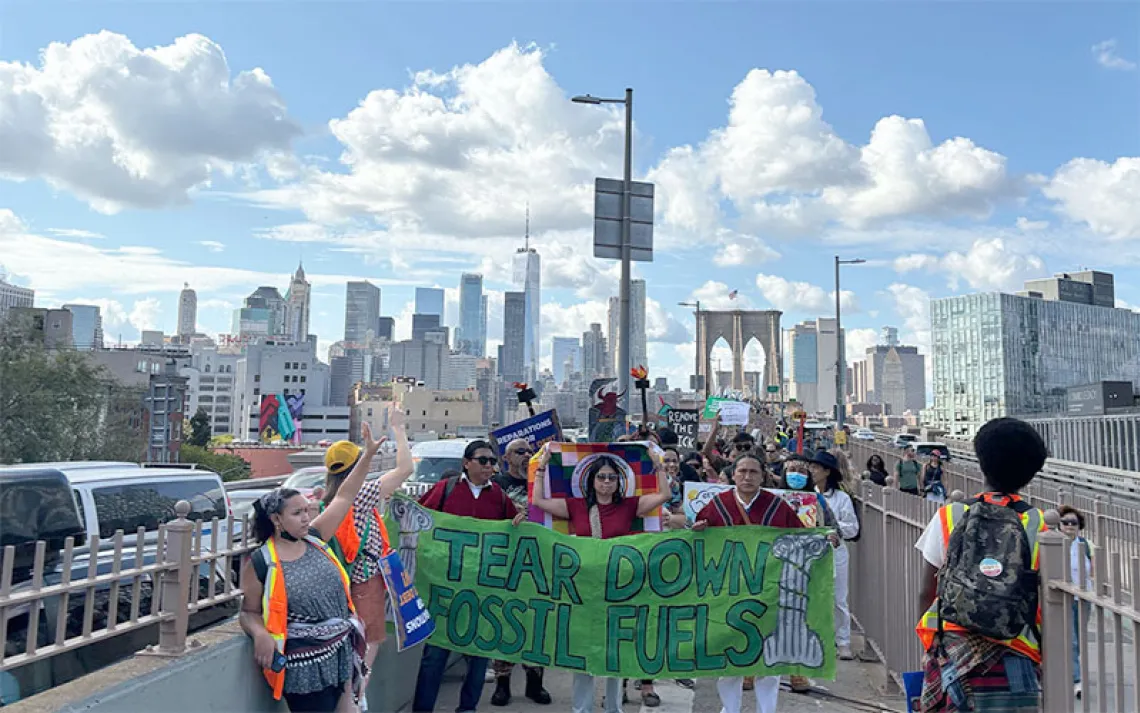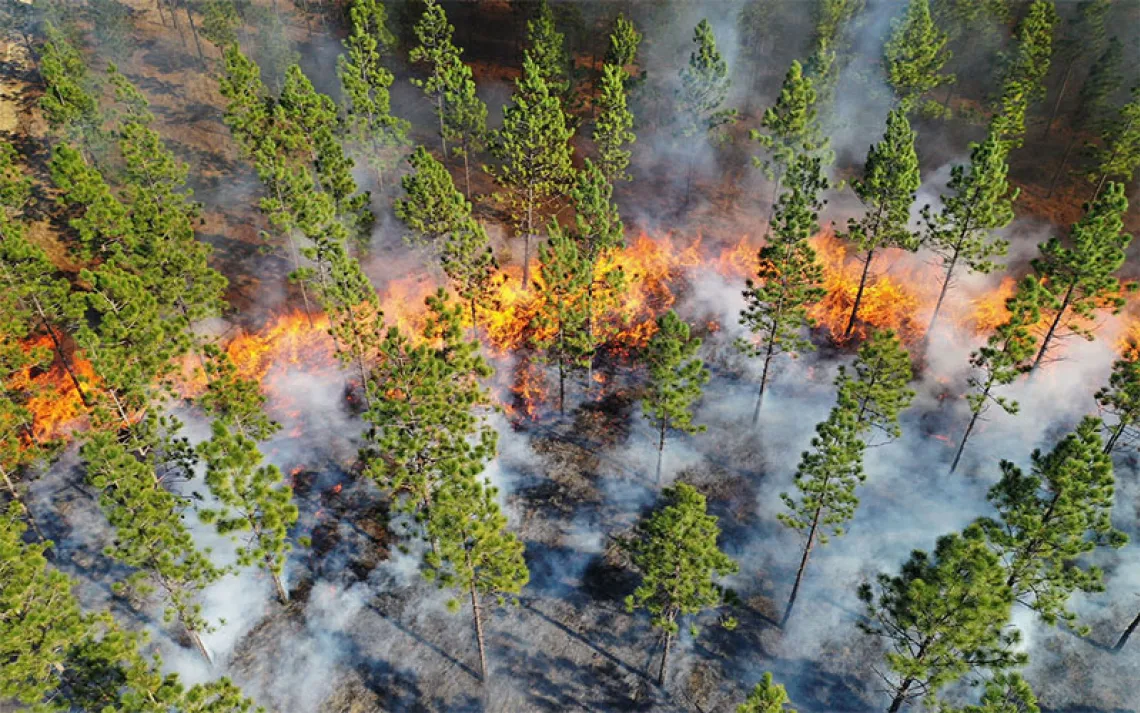Do You Know Where Your Water Comes From?
An Oakland educator follows her tap water 240 miles to the source

Nina Gordon-Kirsch invites passersby on the Bay Trail to ask themselves where their water comes from. | Photo courtesy of Marielle Olentine
It wasn’t until she was 26 and had one degree in environmental science and another in water recycling that Nina Gordon-Kirsch learned where the water in her faucet came from. The Mokelumne River, which carries snowmelt from the Sierra through the Central Valley and out to the San Francisco Bay delta, is surprisingly little-known considering how many lives depend on it.
When I arrived at Gordon-Kirsch’s house in Oakland on a day in late June, I threaded my way to the door through a garden luscious with fat blackberries, ripe apricots, and rustling lavender. I noticed a sign from the youth climate group the Sunrise Movement in her entryway. “For the Water We Drink,” it read. In her kitchen, Gordon-Kirsch was washing a peanut-butter-and jelly-covered knife. She planned to trace, in reverse, the 240-mile journey that every drop of water in her sink had taken. She estimated that it would take 30 days; I was here to join her for the first three.
Gordon-Kirsch and I, along with her friend Te Martin, set off walking toward the city of Richmond on the San Francisco Bay Trail. There was no sign of the Mokelumne yet; it’s just one of the many rivers and creeks that empty into the bay. Still, Gordon-Kirsch laid a clay hamsa—a symbol of her Jewish faith—along the shore of San Francisco Bay as an offering to the water. We set off singing a song about the ocean’s vastness.
“I feel called by the water,” said Gordon-Kirsch. Her professional life has been guided by water. She worked at the San Francisco Bay Regional Water Quality Control Board, taught a class on California water at San Francisco’s Urban School, and became a certified gray water installer. That outrageously fecund garden I mentioned? It’s irrigated entirely by a gray-water system she installed herself.
It’s been five years since Gordon-Kirsch began planning this journey. The idea popped into her head after watching the film The Longest Straw, which chronicles director Samantha Bode’s 338-mile trek along the Los Angeles Aqueducts and Mono Extension. As she walked, Bode explored the ecological and social impacts of a century of extracting water from landscapes like the Owens Valley to feed LA’s growing population. Gordon-Kirsch plans to use footage of her walk, shot by videographers accompanying her along the way, to create a documentary and curriculum about the Mokelumne for East Bay public school students.

Now is the time for environmental journalism.
Sign up for your Sierra magazine subscription.
With this action you affirm you want to receive Sierra Club communications and may vote on policy designated by the Sierra Club Board.
Gordon-Kirsch’s walk was also inspired by Walking Water, a group that leads journeys that are equal parts spiritually and environmentally focused. (On its website, Walking Water asks participants to walk with “political prayer” in their hearts.) “I think of mine as a mixture of the two—I’m not only tracing a municipal water system and educating urban folks about where their water comes from,” Gordon-Kirsch said. “I’m also listening to the water and paying attention to the water.”
*
On my first day, I was too self-conscious to do much listening. I felt embarrassed about singing publicly, especially the earnest, folksy songs that are commonly sung at organizing meetings, around campfires, and pretty much nowhere else. I worried that it made me seem like a classic treehugger, too floaty to understand the political realities that serious legislators in Washington say make environmental progress impossible.
But as the days went on, I lost more and more of my self-consciousness. Gordon-Kirsch carried a canvas flag printed with the question “Do you know where your water comes from?” and she often stopped joggers, strollers, and smoke-break-takers along the way to pose the question directly. On my three days of walking, I didn’t hear anyone answer correctly. But like any good teacher, she used the question as the starting point of a longer conversation. As they talked, I could see people’s minds turning.
Everyone, it seemed, had a story about water. At the Richmond marina, we met Nick, who told us that he’d sailed to Hawai'i eight times—12 days there, 20 days back. He’d seen so much plastic at sea that once he’d fished an entire chaise lounge out of the water to use aboard. A woman we spoke to at Richmond’s Friendship Park suddenly realized that the green lawn that she was standing on shouldn’t have been that color at all. In the California summer, in the midst of drought, it should have been allowed to fade to gold.
As I walked, I saw how many struggles for access to water could be contained in just a short stretch of shoreline. At Point Molate, we stumbled across an abandoned castle-looking building that was once the site of the world’s largest winery. Shuttered by Prohibition, the US Navy took it over as a fuel depot during World War II, one of many military installations that dominated the waterfront for decades. Today, a developer named Winehaven Legacy LLC wants to turn the site into a waterfront commercial and housing development, while the Guidiville Band of Pomo Indians, which claims Point Molate as part of their ancestral homelands, hopes to finalize a purchase of the land. The history of this waterway, as many others I walked along, is complex, contested, and still being written.
I also found myself thinking more deeply about the water that sustains me. Sweating up hills, I remembered that my own body is mostly water, with veins and capillaries that flow through my body like creeks through the California landscape. I thought of the slogan that the Indigenous-led movement at Standing Rock made unforgettable. “Without water, there is no life,” wrote Oglala Lakota poet Layli Long Soldier. “Simple. True. Resonant, down to our very cells.”
For millennia, the Mokelumne River has been life for the people and wildlife who have lived along its 95 miles of shore. It passes through the territory of the Washoe and Miwok peoples, who fished for Chinook and coho salmon and rainbow trout. According to some sources, Mokelumne is a Miwok word meaning “people of the fishing nets,” suggesting just how intertwined the river was with the Miwok Nation’s existence.
Settler colonialism changed that. On the East Coast, said Gordon-Kirsch, cities were built around water sources. On the West Coast, settlers built cities and brought water to them sometimes over hundreds of miles. At the time, they saw this infrastructure as an amazing engineering feat, but it left little water for fish and wildlife.
This massive water project also sparked tensions between upstream farmers who rely on it to irrigate their crops and the East Bay Municipal Utilities District, which has the right to pipe 325 million gallons daily from the Mokelumne River watershed to the Pardee Reservoir, the primary source of the East Bay’s drinking water.
California’s third consecutive year of climate-fueled drought is stretching the Mokelumne’s resources even further. The river is sustained by the snow that falls in the Sierra in winter and early spring. But this year saw the driest January to March in a hundred years, which meant that in April, when the snowpack was supposed to be at its peak, it was at just 38 percent of average. The East Bay Municipal Utilities District has now mandated cuts to water use and began preparations to purchase emergency water supplies.
*
A few days after I parted ways with Gordon-Kirsch, the Electra Fire broke out in the Mokelumne River watershed, on the border of Amador and Calaveras Counties in northeast California. It was an early blaze in what the National Interagency Fire Center predicts will be another above-average fire season. Wildfires, UC Berkeley environmental science professor Ted Grantham told me, amplified the risk of ash and sediment fouling water infrastructure and eating up reservoir capacity.
“As the impacts of climate change increase, and water resources are less and less stable, it’s going to be so vital for people to be in touch with the water,” Gordon-Kirsch says. She believes that developing relationships with water will lead people to care for it, in both senses of the word.
It wasn’t until my final day with Gordon-Kirsch that I caught my first glimpse of Mokelumne River water. We’d been joined by Richard Lautze, who had been Gordon-Kirsch’s co-teacher at the Urban School until his recent retirement. As we trudged through an industrial area of Richmond, home to scrap metal facilities, an enormous Chevron refinery, and a busy, truck-filled parkway, Lautze spotted a creek. This was Wildcat Creek, he said, fed by Mokelumne River water collected in the Pardee Reservoir.
He pointed out sycamores, willows, and cottonwoods—a grove of water-loving trees the skinny creek kept alive. On any other day, those trees would have read to me as just a green clump. But at that moment, I could imagine them as part of an ecosystem, a watershed vast and strained, that nevertheless supports so many millions of human and nonhuman lives.
 The Magazine of The Sierra Club
The Magazine of The Sierra Club



